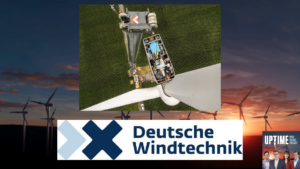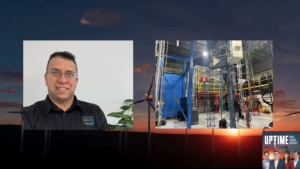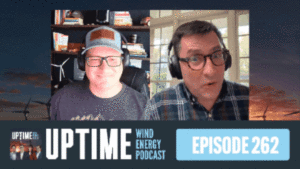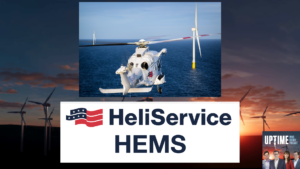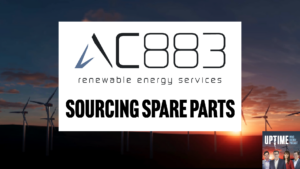Podcast: Play in new window | Download
This week we discuss Vestas’ system to determine the quality of wind turbine blades before recycling and Siemens Gamesa’s noise reduction idea. Then Crosswind’s blade pitching system to increase wake mixing and a seemingly common to patch a hole in the wall.
Visit https://www.intelstor.com/ to inquire about their IP Prism services!
Sign up now for Uptime Tech News, our weekly email update on all things wind technology. This episode is sponsored by Weather Guard Lightning Tech. Learn more about Weather Guard’s StrikeTape Wind Turbine LPS retrofit. Follow the show on Facebook, YouTube, Twitter, Linkedin and visit Weather Guard on the web. And subscribe to Rosemary Barnes’ YouTube channel here. Have a question we can answer on the show? Email us!
Pardalote Consulting – https://www.pardaloteconsulting.com
Weather Guard Lightning Tech – www.weatherguardwind.com
Intelstor – https://www.intelstor.com
Allen Hall: Welcome to Power-Up, the Uptime podcast focused on the new hot off the press technology that can change the world. Follow along with me, Alan Hall and IntelStor’s, Phil Totaro, as we discuss the weird, the wild, and the game changing ideas that will charge your energy future.
All right, Phil, this week, a number of really interesting ideas. This first one comes from Vestas and it is about recycling a wind turbine blades. And it’s a, it’s sort of a different approach. The quality of the material that they can recycle out of a wind turbine blade is obviously based upon how that blade has been treated or how, what its life looked like ahead of time.
So they’re The patent idea is to use machine learning to determine the quality of the recycled material up front, so they can process the blades more efficiently. That’s an interesting approach. Come on. Vestas,
Philip Totaro: obviously, very creative company. And to be able to characterize the, the lifespan of the material prior to trying to take it into the recycling phase.
Because the quality of the material that you’re recycling may end up impacting the, post recycling usage. So for instance, if you’re trying to put it into concrete, you may need a certain grade of, fiber. That, that is something that could, as, as the industry continues to kind of grow with this recycling initiatives.
This could come into play in the future, again, I don’t know that you necessarily need machine learning to facilitate all this, I think that’s a bit of a buzzword y, aspect of the invention, but
Joel Saxum: In the grand scheme of things, the way I’m looking at this problem is this, recycling a blade engineer, or blades, hot topic.
AI machine learning, hot topic, great way for Vestas to throw these together and boost this thing out for an ESG stamp that says, we’re working on this and we’re using AI to blah, blah, blah. At the end of the day, you need the bill of materials with what the blade was originally built with, and you need to know whether they got some crazy kind of LEP on it, or different blade coding for de icing or something, and that’s it.
Allen Hall: The second idea comes from Siemens Gamesa and. It’s the, the Bose headset of wind turbine blades. That’s the only way I can describe this thing where it’s a noise reduction system. It’s active noise. So what they do like Bose does is they create an opposite signal. To, to knock, to cancel the, the noise that the blade is making.
So they have an actuator that sits on the blade and then it has speakers in it and a little gas chamber to improve its sound ability. And they can do active noise canceling on a blade. Now Phil, what I’m wondering is, it’s a, it’s a cool idea and it’s been used in aircraft for a long time. Is it something that would be used on a Winturn blade?
I mean, they only have very, very narrow applications, I would think.
Philip Totaro: Here’s what’s interesting about it, is you’re correct that I, I haven’t actually seen this in use. I would assume that they’ve done some testing on it. Certainly some, lab testing and potentially some field testing, although likely at a test site.
I as opposed to an actual wind farm. The technology we have today is pretty much all passive in terms of serrated trailing edges or other, you can even kind of orient the vortex generators on, on the blade to provide you with the, the performance benefit and the aero benefit of it, but also minimize the noise.
But those are all passive solutions. Something like this, As you mentioned, it’s, it’s literally trying to do, active noise cancellation on, the, the vortices that, that come off the, the blade. And it’s a clever idea, to be sure. Whether or not we need it is another question, because as we’re looking, particularly in Europe, as we look to push setbacks to smaller and smaller distances, going from maybe 1, 500 meters to 1, 000 meters to 500 meters in some countries, this could come into play and you could need something beyond what you can get out of the, the, decibel reduction from serrated trailing edges, for example, And this act of noise cancellation may, may be necessary.
Allen Hall: And our last wind focused idea is, and you see this a lot, is changing the orientation of a wind turbine upstream. So the downstream turbines you have are more efficient. Most of that is focused and that effort is focused on ya moving the turbines in ya. This patent by a company called Crosswind CV is.
saying they can do a similar thing by pitching the angle of the blades as they rotate to vary the induction factor. And then that creates a wake behind the turbines that change over time, increasing wake mixing. So instead of just turning the turbine a little bit, Now you’re actively moving the blades to create a downwind effect.
This sounds interesting, Phil. It’s a different approach, for sure. But there’s some load issues on the blades that I would be concerned about. Is, is that why it hasn’t been implemented yet? Because it does seem like a good idea.
Philip Totaro: You are correct that a, a pitch only solution would necessarily introduce a some amount of asymmetric loading potentially, which does, introduce, fatigue issues, and, and, component life issues on pitch bearings, and, and even the main shaft, and, and, et cetera.
But, there’s nothing that says that they wouldn’t necessarily try to combine this technology with yaw as well. Because what you really want to be able to do, the whole point of wake steering is that you don’t either introduce loads into turbines that are downstream from an upstream turbine, or you also don’t want to impact the air performance of the turbines downstream.
So this is a way to Potentially combine this pitch control system with yaw control to be able to, specifically channel And steer that wake in in a way that yaw control alone wouldn’t necessarily allow you to do So it’s pretty clever and I’m, I’m gonna say, a lot of things are pretty clever but I believe that they are going to crosswind which again is Idiko and Shell.
I believe they are going to test this at some of the new North Holland coast wind farms that they’re currently in the process of building and, and getting commissioned. So I believe this technology will be tested and they’ll, hopefully see a benefit out of the development of this this innovation.
Joel Saxum: What I would like to see and maybe maybe crosswinds before they get out to the field with this is Alan and I just had a great conversation a couple months ago with R& D test systems engineers that are working on hybrid testing for and a lot of it is for pitch bearings and some of the other components that are hard to test.
I’d like to see them put something like this. Through its paces in a hybrid testing environment before they get offshore, because offshore, I see a lot of costs skyrocketing by doing this. Now, again, I haven’t dove into the, the engineering completely behind this. I’ve just read a patent on it. So that might again, my opinion is from an armchair engineer, but unless you’re going to gain a significant amount of AEP on some large turbines, the O and M costs skyrocketing, In the long run may offset the a EP gains.
Allen Hall: And for our fun patent of the week, we are looking into repairing a hole in a wall and who hasn’t punched a hole in a wall lately. And at an inventor in Newport Beach, California has a, pat has a patent that describes how you can fix that hole. You punch the wall after watching the Cowboys game. And basically, this patent is the world’s simplest thing, Phil, and I’m struggling to understand how they actually got a patent for this.
So, you punch a hole in the wall, okay, you got this odd shaped hole in the wall, kind of fish shaped hole, and then what the patent says is, well, you make that hole square, a normal shape, and then you cut another piece of drywall out, that exactly the same shape, and you stuff it in there, and you patch it over.
If this is a real patent, this gentleman from Newport Beach is extremely wealthy, because I’ve seen this on television, on those Home and Gardening Fix It Up shows, I’ve seen this used a thousand times. So is it
Philip Totaro: real? Keep in mind that this particular patent, and it is a patent, Alan, it was issued in 2006, but filed by somebody originally in 2001.
And, based on that, I would like to think that somebody had probably popped a hole in a wall before and patched it up with dry, drywall and a spackle, which is basically what this, this patent describes. I would like to think that prior to 2001, the that, that concept has been utilized.




